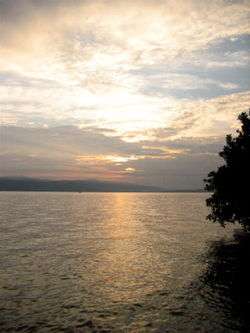Lake Matano
| Matano | |
|---|---|
 Lake Matano at sunset | |
| Location | South Sulawesi, Indonesia |
| Coordinates | 2°29′7″S 121°20′0″E / 2.48528°S 121.33333°ECoordinates: 2°29′7″S 121°20′0″E / 2.48528°S 121.33333°E |
| Type | Tectonic |
| Primary outflows | Penten River |
| Basin countries | Indonesia |
| Max. length | 28 km[1] |
| Max. width | 8 km[1] |
| Surface area | 164.1 km² |
| Max. depth | 590 m[1] |
| Surface elevation | 382 m[1] |
Lake Matano (Indonesian: Danau Matano), also known as Matana, is a natural lake in South Sulawesi, Indonesia. With a depth of 590 m (1,940 ft), it is the deepest lake in Indonesia (ranked by maximum depth), and the 10th deepest lake in the world. The surface elevation from mean sea level is only 382 m (1,253 ft), which means that the deepest portion of the lake is below sea level (cryptohollow). It is one of the two major lakes (the other being Lake Towuti) in the Malili Lake system.
Endemic animals and plants
Lake Matano is home to many species of endemic fish and other animals (e.g. Caridina shrimps,[2] Parathelphusid crabs[3] and Tylomelania snails[4]) as well as many plants. The endemic fishes of Matano have been compared to the species swarms of the Rift Valley Lakes of Africa. While not as diverse, they are thought to have all arisen from a single ancestor species and diversified into numerous different species, which now fill many of the previously vacant ecological niches, as can be seen in the family Telmatherinidae.[5] Endemic and near-endemic fishes from other families include Glossogobius matanensis, Mugilogobius adeia, Nomorhamphus weberi and Oryzias matanensis. Many of the endemics are seriously threatened due to pollution and predation/competition from a wide range of introduced fishes, including flowerhorn cichlids.[6]
The water snake Enhydris matannensis is only known from the vicinity of Lake Matano and on Muna Island.[7]
Environmental concerns
Despite Lake Matano's remote location, it is the site of PT Vale Inco Indonesia Tbk (formerly PT. INCO), one of the largest nickel mines in the world, which carries out strip mining in the surrounding rainforest. Although large areas are cleared for mining the company has a well regarded rehabilitation program and award-winning sediment control systems. The vast areas of rainforest are replaced by mono-cultures of largely non-native trees to counter erosion but doing little to address the loss of biodiversity and the environmental services this provides. The waters of Lake Matano are exceptionally clear, visibility is good, and many of the fish species are highly dependent on visual cues and colour perception for their mating behaviour. If the sediment washing into the lake continues to increase, the likelihood is that many of these endemic species will be lost.
Chemistry
Below the top layer of oxygenated water, Lake Matano's depths are anoxic, free of sulfates, and rich in iron.[8] These conditions make Lake Matano an analog for Earth's oceans during the Archean Eon,[9] which is useful for studying relationships between anoxygenic phototrophs and banded iron formations.[10] The lake contains a population of green sulfur bacteria that conducts photosynthesis with bacteriochlorophyll e.[10]
Lake Matano Festival
To lure foreign tourists of the beauty of Lake Matano and surrounding as a new icon of South Sulawesi, the first annually Lake Matano Festival will be held in May 2015 with some attractions such as competition of running, cycling and swimming.[11]
References
- 1 2 3 4 Crowe, Sean A. (2008), "The biogeochemistry of tropical lakes: A case study from Lake Matano, Indonesia" (PDF), Limnology and Oceanography, 53 (1): 319–331, doi:10.4319/lo.2008.53.1.0319
- ↑ von Rintelen, K., and Y. Cai (2009). Radiation of endemic species flocks in ancient lakes: systematic revision of the freshwater shrimp Caridina H. Milne Edwards, 1837 (Crustacea: Decapoda: Atyidae) from the ancient lakes Of Sulawesi, Indonesia, with the description of eight new species. Raffles Bulletin of Zoology 57: 343-452.
- ↑ Chia, O. C. K. and Ng, P. K. L. (2006). The freshwater crabs of Sulawesi, with descriptions of two new genera and four new species (Crustacea: Decapoda: Brachyura: Parathelphusidae). Raffles Bulletin of Zoology Singapore 54: 381–428.
- ↑ von Rintelen , T., K. von Rintelen, and M. Glaubrecht (2010). The species flock of the viviparous freshwater gastropod Tylomelania (Mollusca: Cerithioidea: Pachychilidae) in the ancient lakes of Sulawesi, Indonesia: the role of geography, trophic morphology and colour as driving forces in adaptive radiation. pp. 485-512 in: Glaubrecht, M., and H. Schneider, eds. (2010). Evolution in Action: Adaptive Radiations and the Origins of Biodiversity. Springer Verlag, Heidelberg, Germany.
- ↑ Herder, F., J. Pfaender, and U.K. Schliewen (2008). Adaptive sympatric speciation of polychromatic "roundfin" sailfin silverside fish in Lake Matano (Sulawesi). Evolution 62(9): 2178-95
- ↑ Herder, F., U.K. Schliewen, M.F. Geiger, R.K. Hadiaty, S.M. Gray, J.S. McKinnon, R.P. Walter and J. Pfaender (2012) Alien invasion in Wallace's Dreamponds: records of the hybridogenic “flowerhorn” cichlid in Lake Matano, with an annotated checklist of fish species introduced to the Malili Lakes system in Sulawesi. Aquatic Invasions 7(4): 521–535
- ↑ Murphy, J. (2010). "Enhydris matannensis". IUCN Red List of Threatened Species. Version 2012.2. International Union for Conservation of Nature.
- ↑ Perkins, Sid (2009), "The iron record of Earth's oxygen", Science News (published 2009-06-20), 175 (13), pp. 24–28, doi:10.1002/scin.5591751321, ISSN 0036-8423, retrieved 2009-06-30
- ↑ Crowe, Sean (2008), Biogeochemical cycling in iron-rich Lake Matano, Indonesia: An early ocean analogue, Department of Earth and Planetary Sciences, McGill University, retrieved 2009-06-30
- 1 2 Crowe, Sean; Jones, CarriAyne; Katsev, Sergei; O'Neill, AH; Sturm, A; Canfield, DE; Haffner, GD; Mucci, A; et al. (2008), "Photoferrotrophs thrive in an Archean Ocean analogue", Proceedings of the National Academy of Sciences (published 2008-10-14), 105 (41), pp. 15938–43, doi:10.1073/pnas.0805313105, ISSN 0148-0227, PMC 2572968
 , PMID 18838679, retrieved 2009-06-30
, PMID 18838679, retrieved 2009-06-30 |first4=missing|last4=in Authors list (help) - ↑ IIN NURFAHRAENI DEWIPUTI (February 22, 2015). "Lake Matano Festival to be South Sulawesi's Cultural Attraction".